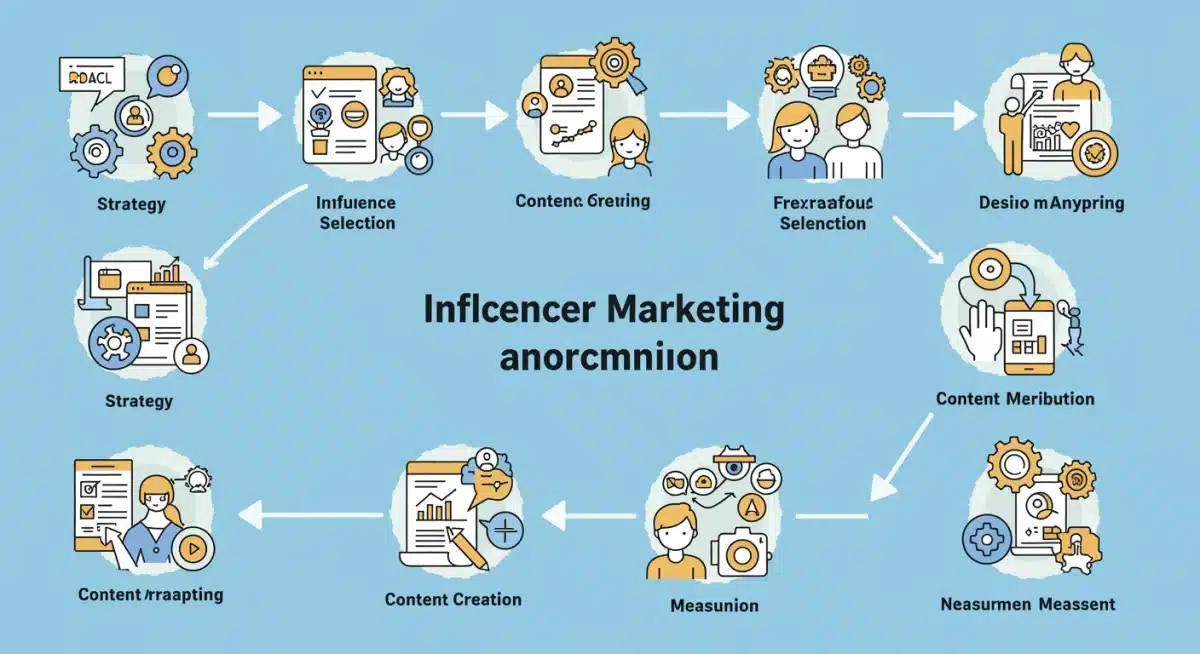Influencer Marketing 2025: 300% ROI for US Brands

US brands are poised for significant financial gains, with projections indicating a 300% ROI from strategic influencer marketing by 2025 by leveraging data-driven approaches and emerging platform integration.
As 2025 approaches, understanding how to maximize returns from digital strategies is paramount for US brands. This report directly addresses the critical question of how to achieve significant financial impact, specifically focusing on how Leveraging Influencer Marketing in 2025: A Guide to Achieving 300% ROI for US Brands (FINANCIAL IMPACT) will reshape marketing landscapes.
The Evolving Landscape of Influencer Marketing
The realm of influencer marketing is undergoing rapid transformation, moving beyond mere celebrity endorsements to encompass a more nuanced and data-driven approach. Brands are now seeking authentic connections and measurable outcomes, shifting focus from follower count to engagement rates and conversion metrics. This evolution directly impacts how US brands approach their campaigns, demanding greater sophistication and strategic alignment with business objectives.
Recent developments indicate a strong move towards micro and nano-influencers, who often boast higher engagement and foster a deeper sense of community. This trend is fueled by consumers’ growing skepticism towards overt advertising and a preference for genuine recommendations from trusted, relatable voices. Brands are recognizing the immense value in these smaller, yet highly impactful, partnerships.
Shifting Focus to Authenticity and Niche Audiences
The days of solely chasing mega-influencers for broad reach are diminishing. Brands are increasingly prioritizing authenticity and relevance, understanding that a smaller, highly engaged audience can yield superior results. This strategic pivot ensures messages resonate more deeply with target demographics.
- Micro-influencers: Typically 10,000-100,000 followers, offering specialized content and strong community ties.
- Nano-influencers: Under 10,000 followers, known for exceptional engagement and highly niche markets.
- Authenticity Metrics: Brands now scrutinize engagement rates, comment quality, and audience demographics more than follower count.
Data-Driven Strategies for Optimal ROI
Achieving a 300% ROI in influencer marketing by 2025 is not a matter of chance; it requires rigorous data analysis and strategic planning. US brands must move beyond anecdotal evidence and embrace robust analytical tools to identify the right influencers, optimize campaign performance, and accurately measure financial impact. This involves leveraging AI-powered platforms and predictive analytics to forecast potential returns.
The integration of first-party data with influencer campaign analytics is becoming crucial. Brands are using their own customer insights to inform influencer selection, ensuring alignment with their existing customer base and identifying potential new segments. This data-centric approach minimizes risk and maximizes the likelihood of achieving ambitious ROI targets.
Leveraging AI and Predictive Analytics
Artificial intelligence is revolutionizing how brands identify, vet, and collaborate with influencers. AI tools can analyze vast amounts of data to pinpoint influencers whose audience demographics, interests, and engagement patterns align perfectly with a brand’s objectives. This precision drastically improves campaign effectiveness.
- Influencer Matching: AI algorithms match brands with influencers based on audience overlap, content synergy, and past performance.
- Performance Forecasting: Predictive analytics estimate potential reach, engagement, and conversion rates before campaign launch.
- Fraud Detection: AI helps identify fake followers and engagement, ensuring investment goes to legitimate influencers.
Measuring Financial Impact: Beyond Vanity Metrics
For US brands aiming for a 300% ROI, the true measure of success lies in financial impact, not just likes or shares. This necessitates a shift from vanity metrics to concrete business outcomes such as sales, lead generation, and customer lifetime value. Establishing clear KPIs and attribution models before campaign launch is paramount to accurately assess profitability.
Brands are increasingly implementing sophisticated attribution models that can track the customer journey from initial influencer exposure to final purchase. This precise measurement allows for a clear understanding of which influencers and content formats are driving the most significant financial returns, enabling continuous optimization and refinement of strategies.

Key Performance Indicators for ROI Measurement
Defining the right KPIs is critical for evaluating the financial success of influencer marketing campaigns. These indicators must directly correlate with revenue generation and business growth, providing a clear picture of investment returns.
- Cost Per Acquisition (CPA): Measures the cost to acquire one customer through influencer efforts.
- Return on Ad Spend (ROAS): Calculates the revenue generated for every dollar spent on influencer campaigns.
- Customer Lifetime Value (CLTV): Assesses the total revenue a brand can expect from a customer acquired via influencer marketing.
- Conversion Rate: Percentage of influencer-driven traffic that completes a desired action, such as a purchase or signup.
Emerging Platforms and Content Formats
The influencer marketing landscape is constantly reshaped by new platforms and evolving content formats. For US brands to achieve aggressive ROI targets, staying ahead of these trends is non-negotiable. Platforms like TikTok, YouTube Shorts, and newer interactive live-streaming services offer unique opportunities for engaging audiences and driving conversions, often at a lower cost than traditional channels.
Short-form video content, in particular, continues its dominance, demanding creative and concise messaging from influencers. Interactive experiences, such as live shopping events hosted by influencers, are also gaining traction, offering direct pathways to purchase and fostering immediate engagement. Brands must adapt their content strategies to leverage these dynamic formats effectively.
The Rise of Short-Form Video and Interactive Experiences
Short-form video platforms have fundamentally altered content consumption habits. Their addictive nature and high engagement rates make them ideal for influencer collaborations that aim for rapid brand awareness and direct response. Interactive formats further bridge the gap between content and commerce.
- TikTok & YouTube Shorts: Dominant platforms for viral content and quick brand messaging.
- Live Shopping: Influencers host real-time product demonstrations and sales, driving immediate conversions.
- Augmented Reality (AR) Filters: Branded AR experiences enhance product interaction and shareability.
Building Long-Term Influencer Relationships
Transactional, one-off campaigns are increasingly giving way to long-term partnerships built on mutual trust and shared objectives. For US brands seeking sustained growth and a 300% ROI, fostering enduring relationships with key influencers is a strategic imperative. These sustained collaborations lead to more authentic content, deeper audience loyalty, and ultimately, greater financial returns over time.
Long-term relationships allow influencers to become genuine brand advocates, integrating products or services more seamlessly into their content and personal narratives. This consistency builds stronger brand recognition and trust among their followers, translating into higher conversion rates and repeat purchases for the brand. It’s an investment in sustained brand equity.
Cultivating Advocacy Through Strategic Partnerships
Moving beyond single campaigns to multi-year agreements transforms influencers into integral parts of a brand’s marketing ecosystem. This deep integration results in more persuasive and credible messaging, which significantly boosts campaign performance.
- Brand Ambassadors: Influencers who consistently represent the brand across various campaigns and platforms.
- Co-creation: Collaborating with influencers on product development or marketing strategies, giving them a vested interest.
- Performance-Based Contracts: Tying influencer compensation to tangible results, aligning incentives for maximum ROI.
Regulatory Compliance and Ethical Considerations
As influencer marketing matures, regulatory bodies are increasing their scrutiny, particularly in the US. Brands must navigate a complex landscape of disclosure requirements, advertising standards, and consumer protection laws. Ensuring full compliance is not just about avoiding penalties; it’s about maintaining consumer trust and safeguarding brand reputation, which directly impacts long-term financial viability.
Transparency is paramount. Clear disclosure of sponsored content, accurate representation of product benefits, and adherence to platform-specific guidelines are critical. Ethical considerations extend beyond legal requirements to include fair compensation for influencers, responsible data handling, and promoting diversity and inclusion within campaigns. Brands that prioritize ethics build stronger, more resilient marketing foundations.
Navigating FTC Guidelines and Industry Standards
The Federal Trade Commission (FTC) sets strict guidelines for influencer disclosures in the US. Brands and influencers must clearly communicate any material connection, ensuring consumers understand when content is sponsored. Non-compliance can lead to significant fines and reputational damage.
- Clear Disclosures: Using hashtags like #ad or #sponsored prominently in posts.
- Authenticity Requirement: Influencers must genuinely use and believe in the products they endorse.
- Data Privacy: Adhering to consumer data protection laws when collecting and using audience information.
| Key Aspect | Brief Description |
|---|---|
| Strategic Shift | Focus on micro/nano-influencers and authenticity over follower count for deeper engagement. |
| Data-Driven Decisions | Utilizing AI and predictive analytics for influencer selection and campaign optimization. |
| ROI Measurement | Moving beyond vanity metrics to track CPA, ROAS, and CLTV for financial impact. |
| Ethical Compliance | Adhering to FTC guidelines and fostering transparency to maintain consumer trust. |
Frequently Asked Questions About Influencer Marketing ROI
Achieving a 300% ROI involves strategic planning, data-driven influencer selection, and meticulous performance tracking. Focus on niche influencers, leverage AI for audience matching, and prioritize long-term partnerships for sustained growth and measurable financial returns.
Beyond engagement rates, crucial metrics include Cost Per Acquisition (CPA), Return on Ad Spend (ROAS), and Customer Lifetime Value (CLTV). These provide a clear financial picture of campaign effectiveness and directly link influencer efforts to revenue generation.
Micro-influencers often have highly engaged and specialized audiences, leading to more authentic recommendations and higher conversion rates. Their niche focus allows for more targeted campaigns, resulting in better alignment with specific brand goals and improved ROI.
New platforms like TikTok and interactive formats such as live shopping offer dynamic ways to engage audiences. Brands must adapt content strategies to these evolving channels to capture attention, drive immediate purchases, and maintain a competitive edge for optimal ROI.
Adhering to FTC guidelines and maintaining transparency are critical for building and sustaining consumer trust. Ethical practices, including clear disclosures and fair compensation, protect brand reputation and ensure the long-term viability and effectiveness of influencer partnerships.
What Happens Next
The trajectory for Leveraging Influencer Marketing in 2025: A Guide to Achieving 300% ROI for US Brands (FINANCIAL IMPACT) indicates a period of intensified strategic evolution. Brands failing to adapt to data-driven approaches, embrace niche influencers, and prioritize ethical compliance risk significant competitive disadvantage. The immediate future will see further integration of AI, more sophisticated attribution models, and a continued emphasis on authentic, long-term influencer relationships. US brands must view influencer marketing not as an isolated tactic but as an integral, financially measurable component of their overall growth strategy, with proactive adaptation being the key to unlocking substantial returns.





